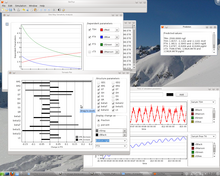SimThyr is a free continuous dynamic simulation program for the pituitary-thyroid feedback control system.[1] The open-source program is based on a nonlinear model of thyroid homeostasis.[2][3][4] In addition to simulations in the time domain the software supports various methods of sensitivity analysis. Its simulation engine is multi-threaded and supports multiple processor cores. SimThyr provides a GUI, which allows for visualising time series, modifying constant structure parameters of the feedback loop (e.g. for simulation of certain diseases), storing parameter sets as XML files (referred to as "scenarios" in the software) and exporting results of simulations in various formats that are suitable for statistical software. SimThyr is intended for both educational purposes and in-silico research.[4][5]
 | |
 SimThyr 3.1 on openSUSE 11 | |
| Original author(s) | Johannes W. Dietrich, Ulla Mitzdorf, Renate Pickardt, Rudolf Hoermann, John E. M. Midgley |
|---|---|
| Developer(s) | Ruhr University Bochum |
| Initial release | 2002 |
| Stable release | 4.0.6
/ April 23, 2022 |
| Repository | |
| Written in | Pascal and Object Pascal |
| Operating system | macOS, Windows and Linux |
| Platform | PowerPC, IA-32, x86-64 and ARM, m68k (legacy versions only) |
| Available in | British English, German (SimThyr 2.0 or older only) |
| Type | Free scientific application software for physiological simulations |
| License | BSD-style |
| Website | simthyr |
Mathematical model
editThe underlying model of thyroid homeostasis is based on fundamental biochemical, physiological and pharmacological principles, e.g. Michaelis-Menten kinetics, non-competitive inhibition and empirically justified kinetic parameters.[1] The model has been validated in healthy controls and in cohorts of patients with hypothyroidism and thyrotoxicosis.[6]
Scientific uses
editMultiple studies have employed SimThyr for in silico research on the control of thyroid function.[7][8]
The original version was developed to check hypotheses about the generation of pulsatile TSH release.[9] Later and expanded versions of the software were used to develop the hypothesis of the TSH-T3 shunt in the hypothalamus-pituitary-thyroid axis,[10] to assess the validity of calculated parameters of thyroid homeostasis (including SPINA-GT and SPINA-GD)[11][12] and to study allostatic mechanisms leading to non-thyroidal illness syndrome.[13][14]
SimThyr was also used to show that the release rate of thyrotropin is controlled by multiple factors other than T4 and that the relation between free T4 and TSH may be different in euthyroidism, hypothyroidism and thyrotoxicosis.[15]
Public perception, reception and discussion of the software
editSimThyr is free and open-source software. This ensures the source code to be available, which facilitates scientific discussion and reviewing of the underlying model.[16][17] Additionally, the fact that it is freely available may result in economical benefits.[18][19]
The software provides an editor that enables users to modify most structure parameters of the information processing structure.[20] This functionality fosters simulation of several functional diseases of the thyroid and the pituitary gland. Parameter sets may be stored as MIRIAM- and MIASE-compliant XML files.
On the other hand, the complexity of the user interface and the lack of the ability to model treatment effects have been criticized.[21]
See also
editReferences
edit- ^ a b Dietrich, JW; Landgrafe, G; Fotiadou, EH (2012). "TSH and Thyrotropic Agonists: Key Actors in Thyroid Homeostasis". Journal of Thyroid Research. 2012: 351864. doi:10.1155/2012/351864. PMC 3544290. PMID 23365787.
- ^ Hoermann, R; Midgley, JE; Larisch, R; Dietrich, JW (2015). "Homeostatic Control of the Thyroid-Pituitary Axis: Perspectives for Diagnosis and Treatment". Frontiers in Endocrinology. 6: 177. doi:10.3389/fendo.2015.00177. PMC 4653296. PMID 26635726.
- ^ Berberich, Julian (13 September 2018). "Mathematical Modeling of the Pituitary-Thyroid Feedback Loop: Matlab/Simulink Files for Simulation and Sensitivity Analysis". doi:10.5281/zenodo.1415331.
{{cite journal}}: Cite journal requires|journal=(help) - ^ a b Dietrich, Johannes W. (2002). Der Hypophysen-Schilddrüsen-Regelkreis : Entwicklung und klinische Anwendung eines nichtlinearen Modells. Berlin: Logos-Verlag. ISBN 978-3897228504.
- ^ Dietrich, Johannes W.; Midgley, John E. M.; Hoermann, Rudolf (2018). Homeostasis and Allostasis of Thyroid Function. Lausanne: Frontiers Media SA. ISBN 9782889455706.
- ^ Hoermann, R; Pekker, MJ; Midgley, JEM; Larisch, R; Dietrich, JW (February 2020). "Triiodothyronine secretion in early thyroid failure: The adaptive response of central feedforward control". European Journal of Clinical Investigation. 50 (2): e13192. doi:10.1111/eci.13192. PMID 31815292. S2CID 208956920.
- ^ Ramos, André; Chaves, Rafael; Favero, Elói (11 November 2019). "Simulação baseada em Dinâmica de Sistemas para o ensino da fisiologia do eixo Hipotálamo-hipófise-tireoide no contexto da graduação em medicina". Brazilian Symposium on Computers in Education (Simpósio Brasileiro de Informática Na Educação - SBIE) (in Portuguese). 30 (1): 962. doi:10.5753/cbie.sbie.2019.962. ISSN 2316-6533. S2CID 213401607.
- ^ Ghosh, Devleena; Mandal, Chittaranjan (2020). "Clustering Based Parameter Estimation of Thyroid Hormone Pathway". IEEE/ACM Transactions on Computational Biology and Bioinformatics. PP (1): 343–354. doi:10.1109/TCBB.2020.2995589. PMID 32750849. S2CID 219479222.
- ^ DIETRICH, J. W.; TESCHE, A.; PICKARDT, C. R.; MITZDORF, U. (2004). "Thyrotropic Feedback Control: Evidence for an Additional Ultrashort Feedback Loop from Fractal Analysis". Cybernetics and Systems. 35 (4): 315–331. doi:10.1080/01969720490443354. S2CID 13421388.
- ^ Hoermann, R; Midgley, JE; Larisch, R; Dietrich, JW (2015). "Integration of Peripheral and Glandular Regulation of Triiodothyronine Production by Thyrotropin in Untreated and Thyroxine-Treated Subjects". Horm Metab Res. 47 (9): 674–80. doi:10.1055/s-0034-1398616. PMID 25750078. S2CID 9824656.
- ^ Dietrich, JW; Landgrafe-Mende, G; Wiora, E; Chatzitomaris, A; Klein, HH; Midgley, JE; Hoermann, R (2016). "Calculated Parameters of Thyroid Homeostasis: Emerging Tools for Differential Diagnosis and Clinical Research". Frontiers in Endocrinology. 7: 57. doi:10.3389/fendo.2016.00057. PMC 4899439. PMID 27375554.
- ^ Hoermann, Rudolf; Midgley, John E. M.; Larisch, Rolf; Dietrich, Johannes W. (October 2018). "The role of functional thyroid capacity in pituitary thyroid feedback regulation". European Journal of Clinical Investigation. 48 (10): e13003. doi:10.1111/eci.13003. PMID 30022470. S2CID 51698223.
- ^ Hoermann, R; Midgley, JE; Larisch, R; Dietrich, JW (February 2013). "Is pituitary TSH an adequate measure of thyroid hormone-controlled homoeostasis during thyroxine treatment?". European Journal of Endocrinology. 168 (2): 271–80. doi:10.1530/EJE-12-0819. PMID 23184912. S2CID 34158774.
- ^ Chatzitomaris, A; Hoermann, R; Midgley, JE; Hering, S; Urban, A; Dietrich, B; Abood, A; Klein, HH; Dietrich, JW (2017). "Thyroid Allostasis-Adaptive Responses of Thyrotropic Feedback Control to Conditions of Strain, Stress, and Developmental Programming". Frontiers in Endocrinology. 8: 163. doi:10.3389/fendo.2017.00163. PMC 5517413. PMID 28775711.
- ^ Midgley, JE; Hoermann, R; Larisch, R; Dietrich, JW (April 2013). "Physiological states and functional relation between thyrotropin and free thyroxine in thyroid health and disease: in vivo and in silico data suggest a hierarchical model". Journal of Clinical Pathology. 66 (4): 335–42. doi:10.1136/jclinpath-2012-201213. PMID 23423518. S2CID 46291947. Retrieved 4 December 2018.
- ^ Gezelter, Dan. "SimThyr – simulation software for pituitary thyroid feedback | The OpenScience Project". The OpenScience Project. Archived from the original on 4 April 2019. Retrieved 6 February 2019.
- ^ Glensbo, Henrik. "Fokus i 2020 - stofskiftesygdom.dk". www.stofskiftesygdom.dk. Stofskiftesygdom. Retrieved 2 April 2020.
- ^ Lupínek, Jiří (2012). Freeware simulační a vizualizační nástroje pro GNU/Linux (in Czech). Západočeská univerzita v Plzni. hdl:11025/5282.
- ^ Arslan, M. Oguz (2014). "Özgür ve Açık Kaynak Yazılımın Ekonomik Faydaları: Saglık Sektörü Için Bir Degerlendirme [Economic Benefits of Free and Open Source Software: An Evaluation for Health Sector.]". Hacettepe Sağlık İdaresi Dergisi. 17: 119–31.
- ^ Dietrich, J. W. (2017), SimThyr 4.0 Handbook and Reference, figshare, doi:10.6084/m9.figshare.4902098
- ^ Han, Simon Xian He (2013). THYROSIM: A Web Application for Human Thyroid System Regulation Education and Research (Thesis). Los Angeles: UCLA.
External links
edit- Official website of the SimThyr project
- Curated information at Zenodo
- Curated information at SciCrunch